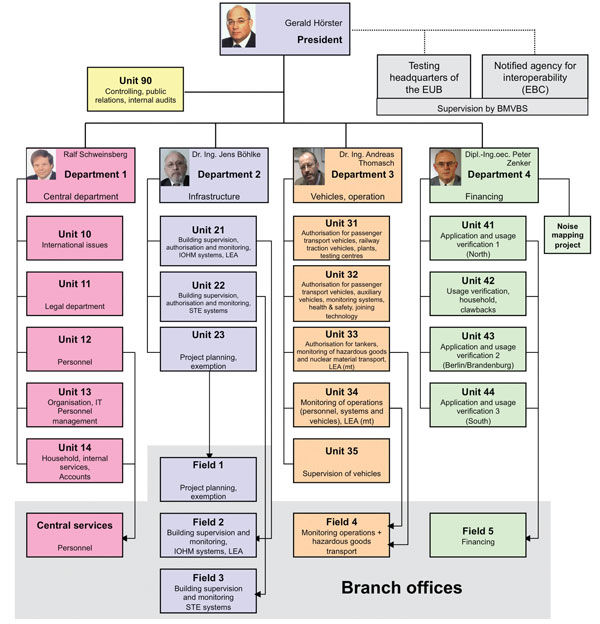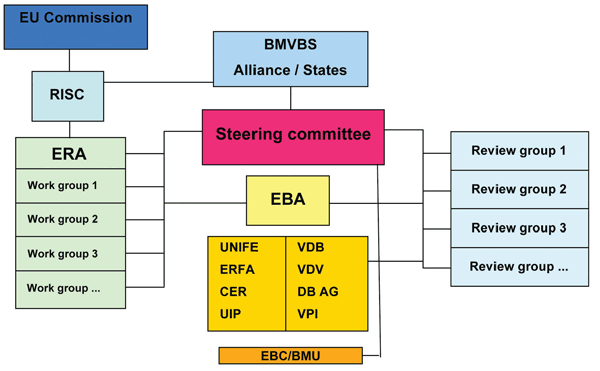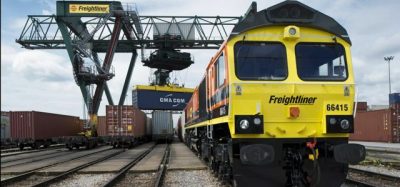The railway system in Germany
Posted: 26 March 2009 | | No comments yet
Gerald Hörster, President of the Federal Railway Authority (EBA) examines its place within Germany’s railway system.
To be able to appreciate which functions the Federal Railway Authority (EBA) fulfils, it is worth taking a cursory glance at the German railway market first. Ranking high within Europe, its hallmark is the vast array of organisations. The public railway network in Germany covers some 38,000km of route, a good 20,000km of which are electrified by Germany’s standard 15 kV and 16 2/3 Hz current system. This route network is looked after by approximately 160 public infrastructure operators, just under 33,000km of the network being operated by DB Netz AG.


Figure 1: Organigram of the Federal Railway Authority (EBA)
Almost 400 public rail transport companies (EVU) hold the authorisation required according to general railway law (pursuant to RL 95/18/EC) to operate this route network. Foreign rail transport companies are also involved in Germany’s railway operation on the basis of an authorisation obtained abroad. In 2007, freight transport performance stood at approximately 115 billion tonne km and passenger transport performance at approximately 79 billion passenger km. In accordance with the statutory provision of § 4, para. 1 of the General Railway Law (AEG), the responsibility for safety on railways lies with the rail companies. These companies are under an obligation to run their operation safely, build safe railway infrastructures, vehicles and equipment and maintain them in a reliable condition. In Germany, the responsibilities for authorisation and supervision in the railway system generally lie with the government. This means the government is responsible for railways that are majority owned by the government (‘federal railways’), while the federal states are responsible for all other private railway companies, referred to as ‘non-federal railways’ headquartered in Germany. The largest ‘federal railway’ is Deutsche Bahn AG.
Responsibilities and organisation of the Federal Railway Authority
Since Germany’s railway system reform in 1994, the EBA has been the supervisory and authorisation authority for the federal railways (EdB) and the rail transport companies (EVU) headquartered abroad for the federal republic region. As part of the merger between the two former state railways, Deutsche Bundesbahn and Deutsche Reichsbahn to create Deutsche Bahn AG, EBA was assigned the sovereign roles that the state railways themselves had until then fulfilled. When the rail safety directive (RL 2004/49/EC) was introduced in Germany in 2007, the Federal Railway Authority became the national safety authority and as such fulfils all the functions of a safety authority as defined by Article 16 of the safety directive. The directive brought with it new functions for the EBA and changed the content or applicable parties of existing ones. It also expanded the EBA’s railway supervisory authorities. As a safety authority, the EBA is also responsible to the federal railways for monitoring non-federal railways; these require a safety certificate or a safety authorisation. In order to fulfil its diverse functions, the EBA is headquartered in Bonn and has 12 branch offices in 15 locations throughout Germany. The headquarters consist of four departments, each with sub-units that also deal with the five key areas in the branch offices. The branch offices fulfil primarily operative functions, whilst the headquarters, alongside its operative role, also handles important fundamental issues.
Functions of the Federal Railway Authority as a National Safety Authority
Authorisation for commissioning and monitoring sub-systems The EBA is responsible for issuing commissioning authorisations for the structural sub-systems:
- Infrastructure
- Energy
- Train control system
- Train safety and signalling
- Traffic operation and traffic control
- Vehicles
These are in accordance with directives 96/48/EC and 2001/16/EC. The commissioning authorisations for vehicles are also valid outside of the Trans-European Network (TEN). In addition, the EBA holds responsibility for authorising the commissioning of sub-systems that are not yet part of a Technical Specification for Interoperability (TSI). The EBA must also check that the sub-systems satisfy the fundamental requirements during operation. This is done as part of the random railway supervision via the aforementioned sub-systems.
Safety certificate and safety authorisation
Rail transport companies involved in public rail traffic require a safety certificate; public infrastructure operators require a special safety approval. Only regional railways, operators of regional service equipment and networks with no links abroad are exempt from this obligation. The safety certifications and safety authorisations are issued by the EBA in accordance with the provisions of RL 2004/49/EC. The EBA is also responsible for monitoring ongoing compliance with the fundamental requirements.
National Safety Regulations
The EBA is responsible for monitoring compliance with the regulations stipulated by public railways, which include requirements for guaranteeing railway safety and which apply for more than one railway. The background to this function is a paradigm shift in the definition of railway safety. In the state railway era, it was usual for each company to determine for itself how it guaranteed safety – this is no longer the case. In future, standardised methods, procedures and objectives are to be observed. The standard European procedure for railway safety will dismantle barriers to market entry in this sector. In this, the EBA is playing a central role in defining, monitoring, advancing and publishing the national safety regulations in accordance with Article 8 of the Safety Directive. The changes to the national safety regulations are defined and notified to the EU Commission through the BMVBS following consultation with representatives of the federal states and the EVU and infrastructure operators. The EBA ensures that the notified regulations are published on the Internet.
National Vehicle Register
The EBA holds the National Vehicle Register in accordance with Article 14 of the Interoperability Directives (and/or Article 33 of RL 2008/57/EC). This National Vehicle Register is soon to become part of the so-called European Centralised Virtual Vehicle Register. The vehicle fleet operating on the TEN is entered into this register. Before a vehicle can be assigned a commissioning authorisation, it needs a European Vehicle Identification Number. This number is the basis of a standard European vehicle identification system to expedite deregulation at this point.
Market surveillance
Market surveillance is made up of so-called interoperability components. As these components are not subject to state authorisation by the safety authorities, the EBA monitors compliance with the safety and interoperability requirements as part of its market surveillance activities.
Training facilities
Training facilities for train drivers and crew require authorisation from the safety authority. The EBA not only monitors activities within the training facilities themselves, it also makes these facilities available to the third parties. The idea is to help open up the market for new rail transport companies.
Safety advisory council
The transfer of the authorities for all non-federal railways requiring a safety authorisation and/or safety certificate from the federal states to the EBA has resulted in the establishment of a safety advisory council. On this safety advisory council, representatives of the transport ministries in all federal states consult with the Federal Ministry for Transport, Building and Urban Affairs (BMVBS) on all matters regarding the functions of the EBA in its capacity of safety authority. The EBA manages this body.
Looking towards Europe
The European Railway Agency
When the European Railway Agency (ERA) was established in Lille, the European Commission had to step up its harmonisation and liberalisation efforts for creating a standard European railway environment. The ERA is collaborating with numerous work groups and task forces, bringing in specialists from the national railway authorities and from the European railway associations to develop new, pan-European regulations. To help realise the European goal of an interoperable railway system, the EBA cooperates with specialists from all fields and gets involved in international bodies, including the ERA work groups for coordinating and harmonising processes and criteria for authorisation and supervision at European level. Both in high-speed transport as well as conventional transport, Technical Specifications for Interoperability (TSI) have been introduced to realise an interoperable European railway system. Others are set to follow. These TSI contain both the requirements and also the test procedures for interoperability components and sub-systems. The ERA is also responsible for developing and updating the TSI. It is the job of the ERA to foster and coordinate collaboration between the national safety authorities. This is reflected in the work of the NSA Network. The network holds bi-monthly meetings at which the representatives of the safety authorities are given an overview of the ERA’s activities and key issues are discussed.
Steering committee
In order to fulfil functions at European level, the EBA is also the interface with the national partners from businesses and associations. German interests are grouped and coordinated by the interoperability and safety committee established for this very purpose. Managed by the BMVBS, this steering committee is made up of representatives from the federal states, the German railway industry, the German railways and the Eisenbahn-Cert (EBC) as the notified body for ‘Interoperability’. The members of the steering committee can access all information on the European activities relevant to them on the website www.lenkungskreis.de. Review groups, which, running parallel to the ERA work groups, discuss the subjects of relevance to those groups and prepare national reports for European legislation, have been set up below the steering committee. The review group management usually take EBA personnel, who are also members of the corresponding ERA work group. The reports compiled within the review groups are harmonised in the steering committee and then introduced into the ERA work groups and the accountable bodies of the European Union (EU).
Cross Acceptance
The EBA is especially dedicated at European level to preparing bilateral agreements, including those for the reciprocal recognition of authorisations for locomotives and rail waggons. The first pan-European agreement of this kind was concluded between Germany and France in 2006 and has since been updated and continuously developed. This agreement was followed in 2007 by a regulation along the same lines with the Netherlands, Austria, Switzerland and Italy. Because these agreements are able to streamline authorisation processes, the EBA is investing immense effort in this area. This is also allowing the railway industry to make the corresponding savings. The results achieved in this context have been taken on board by the European Commission and form the basis of the Cross Acceptance regulations in the new Interoperability Directive 2008/57/EC. The ERA has established its own Cross Acceptance department and a task force for this subject, in which the EBA collaborates by offering its previous experience.
Recognition of notified bodies
The EBA is also responsible for recognising and monitoring ‘Notified bodies’ in Germany for the certification of European rail products in both conventional and high-speed rail traffic in accordance with the Interoperability Directives 96/48/EC and 2001/16/EC (in future also the new RL 2008/57/EC). As part of this recognition process, the EBA verifies whether the criteria specified at European level for the notified bodies are satisfied by the applicant concerned.
Further functions of the Federal Railway Authority in the National and International Railway Environment
Project planning
In Germany, a project planning procedure is stipulated for the erection and alteration of railway systems. The EBA is responsible for implementing the project planning procedure for infrastructure measures for the federal railways, such as the construction of the high-speed routes from Cologne to Frankfurt or from Nuremberg to Ingolstadt. This procedure involves monitoring the effects of the planned project, all those involved and affected being given the opportunity to air their concerns. The EBA weighs up all interests and then takes a decision.
Financing
The EBA also has a duty regarding the financing of investments into the infrastructure of the federal railways. Specifically, it prepares and implements financing agreements between the BMVBS and the infrastructure operator concerned, produces grant approval notices and verifies that the federal and EU funds are being used for their intended, economic purpose. The financing proposals are evaluated in terms of technical and operational necessity, as well as cost-efficiency, as early as the project coordination and proposal assessment phases. From 2009 onwards, a new procedure will be applied for financing investments into the existing network. Until now, the federal infrastructure operators have applied for finance for individual investment projects or for groups of similar activities and been granted the necessary funds. The aim of achieving a defined quality status for the overall rail superstructure was not part of this procedure. Past experience has shown that concentrating on finance for achieving a certain status for the overall rail superstructure is a higher priority than providing funds for financing individual investments. This can increase the infrastructure operators’ level of responsibility for their rail superstructures. Under the terms of a performance and financing agreement, the federal infrastructure operators now receive federal funds in the amount of €2.5 billion per annum for investing in their own rail superstructures. In return, they undertake to make a minimum maintenance contribution and keep their rail superstructures in a wholly usable condition. This is measured using seven quality performance figures. For each year of its term (2009 to 2013), the agreement contains targets for quality performance figures that are verified by the EBA and sanctioned where applicable in case of non-fulfilment. The development of the rail infrastructure status is recorded and hence made transparent by means of an infrastructure status and development report, which also contains an extensive infrastructure land register. This report is to be presented annually.


Figure 2: ERA/EU and national parallel organisation
Licensing and demerging
The EBA is responsible for licensing federal infrastructure operators and rail transport companies. According to the AEG, the authorisation conforms to the license pursuant to RL 95/18/EC. Technical qualification, dependability and financial efficiency of operators and companies are verified prior to licenses being issued. The EBA also checks that these companies comply with the neutrality regulations for the demerger of the infrastructure operators and the rail transport companies, as well as observe the prohibition on the transfer of public funds within companies as stipulated by the EU in RL 91/440/EEC. Transport of hazardous goods and nuclear materials The EBA has a particular supervisory function in authorising and supervising the transportation of hazardous goods and radioactive materials by rail in accordance with the regulation on the intrastate and cross-border carriage of hazardous goods by road and rail (GGVSE) and/or the RID. The EBA also issues prototype authorisations for tank wagons in accordance with GGVSE/RID.
Noise mapping
In 2005, the German legislators reformed the European Environmental Noise Directive 2002/49//EC into national law by way of an amendment to the Federal Clean Air Act. In this regard, the EBA is the authority responsible for compiling noise maps along the federal railway route network.
Bodies, committees and projects
The EBA is represented in numerous work groups, external bodies and committees. In addition to the European presence on the ERA and RID Technical Committee (RID: Regulation on the international carriage of hazardous goods by rail), EBA employees also fulfil roles in other international and national work groups, examples being the German Institutes for Standardisation and Structural Engineering, and particularly in the vehicle technology work group. New EU member states and candidate countries are supported in the restructuring of the rail sector and in fulfilling their functions as a railway safety authority in the form of ‘twinning projects’. To facilitate accession to the EU, the European legal frameworks in the railway system is explained in this project. The EBA holds a lively information exchange event with other safety authorities. A reciprocal staff exchange programme has been agreed with the French authority EPSF.
Outlook
Activities are currently underway in Germany for introducing the third railway package of the EU. The implementation of the railway traction vehicle driving licence directive 2007/59/EC may well create new functions for the EBA. Further activities may also result from Directive 2008/110/EC for amending the safety directive, as this also involve certification for the maintenance of freight wagons. Meanwhile in Europe, decisions are being taken to implement the first common safety methods (CSM). These will be applicable from 01.07.2010 for vehicle authorisation and from 01.07.2012 for all authorisations and will require certain efforts for implementation. As part of its role, the EBA will continue to ensure that the rail transport companies and infrastructure operators assume their legally anchored operator responsibility – hence guaranteeing safety in rail transport. Looking towards the years ahead and focussing on Europe, EBA personnel will continue to actively support, through their commitment and expertise, the ‘creation of a European railway organisation’.







